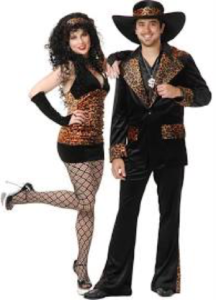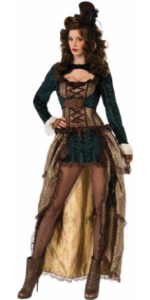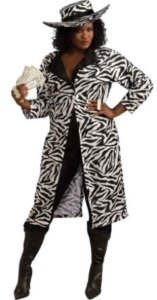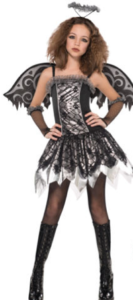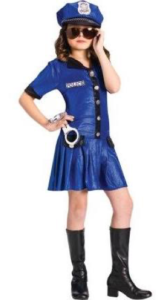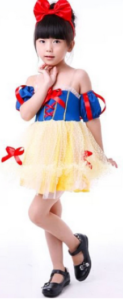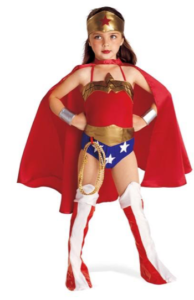[Warning: This Blog Contains Images of Children in Sexualized Costumes]
Halloween is a tradition that originated from the Celtic observance of Samhain, when people wore costumes to ward off the spirits said to visit the earth at the start of winter on November 1. Costumes worn over the centuries have ranged from animal skins, to masks, to traditional attire. Yet in Halloween’s recent history, particularly over the past two decades, Halloween has increasingly become a sexualized observance, especially among girls and young women.
So, how did Halloween transform from a day of donning costumes that ranged from the frightening to the playful, to an occasion when many girls and young women present themselves in sexually provocative ways?
Traditionally, the meaning of the holiday for children has been fairly clear: Halloween represents a day to receive treats and engage in make-believe recreation—to be anything they choose, such as a superhero, fairy-tale creature, animal, or movie character.
For adults, for whom Halloween is becoming a much more popular holiday, the meaning of Halloween is a little different. As Russell W. Belk notes in his 1990 article, Halloween: an Evolving American Consumption Ritual, “The mask and carnival atmosphere of Halloween that allow children to invert the power structure, master fears, and try on different identities, allow the adult to transcend normal rules of propriety and relieve the normal tensions of social order.”
Simply put, Halloween gives adults the opportunity to shed responsibilities and norms in how they dress and act. Combine this with the sexual revolution of the 60’s- 70’s and you have a perfect storm for the modern norm of sexually provocative, young adult costumes.
This normalizing of sexualized Halloween is acknowledged in popular media. As the teenage character Cady Heron of the popular movie Mean Girls says, “In the real world, Halloween is when little kids dress up and beg for candy. In Girl World, Halloween is the one night a year when a girl can dress like a total slut and no other girls can say anything about it.”
This statement reflects an unfortunate reality of today’s costume industry: many male costumes are hyper-masculinized, while female costumes are hyper-sexualized.
One website promotes costumes for males that include sexually provocative jokes and the objectification of woman, using ideas such as a man offering “free mammograms.” The website then assures ladies that they are not forgotten and proceeds to offer them costume ideas. The key advertising tactic is to include the word “sexy” in front of every costume marketed towards women: sexy nurse, sexy soldier, sexy mouse, sexy lamp, sexy batman, etc. It even turns garbage bags into potential sexy costumes for women! What kind of message does “sexy trash” send about the worth of women?
It seems that nothing is safe from receiving the same treatment, including Princess Leia from Star Wars. Many will remember that Leia’s usual clothing was a long white dress that covered her from the neck to her ankles. Yet, one company is promoting a costume which mimics the metal bikini Leia was forced to wear as a slave in the movie. The advertising copy on halloweencostumes.com reads: “Now you can feel sexy and powerful with your own Slave Leia outfit. You may be in chains but you’re the one who’s always in charge of the situation.” I’m sure any slave can tell you quite a different story. News flash: oppression is not “sexy.”
Another Halloween phenomena are “pimp and ho” costumes. Yes, these get ups are available online from a number of costume retailers and even Walmart.com. While the idea may be amusing to some, “ho” costumes mask the stark reality of sexual abuse, violence, and exploitation that define the life of prostituted woman the world over. Pimp and madam costumes on the other hand, normalize and trivialize sexual violence and exploitation.
Despite prevailing stereotypes in popular culture which portray pimping as hip and cool, pimps are in fact violent, serial sexual predators. The federal Trafficking Victims Projection Act (TVPA) defines severe forms of trafficking in persons as the recruitment, harboring, transportation, provisioning, obtaining, patronizing, or soliciting, by means of force, fraud, or coercion, persons for exploitation in the commercial sex trade. This is the quintessence of what pimps do. By definition, pimps are sex traffickers. Thus, anyone dressing as a pimp for Halloween is going as a sex trafficker.
Other websites giving various ideas for Halloween costumes promote Fifty Shades of Gray with lines such as, “Seriously, Halloween is the ideal time to allow ourselves to feel liberated enough to live out our sexy, erotic dreams . . . My vote is on ditching the PG-13 stuff and sticking to the adult celebrations for Halloween this year, and channeling 50 Shades is one surefire way of feeling bold and free.” Why is this so wrong? Because the naïve writer of this column is linking “fun and free” feelings with a book and film which celebrates sexual exploitation in the form of sadomasochism—and tries to normalize it for adults. A similar website includes Fifty Shades of Gray costumes with the tagline: “Handcuffs and whips are ideal accessories for this outfit.”
I’m sorry this has to be said, but sexual subjugation and exploitation in any form disguised in the mantel of liberation is not and will never be freedom.
Other examples of how the combination of violence and sex in culture-at-large is being given further expression include a Pinterest post of a costume idea for a serial killer and his female victim. In this scenario, the costume presents a female murder victim wrapped partially in bloody saran wrap.
What is more disturbing is that the trend of sexualizing children is prevalent in children’s costumes.
Girls’ costumes are commonly hypersexualized with short skirts, thigh high or leather boots, laced bodices, and off the shoulder tops. What is most disturbing is the similarity of the girls’ poses in costumes to the poses in the pornified women’s costumes. Not only do the costumes objectify girls, but they are also highly impractical for the cold temperatures and occasional snow of late October. Too often the images evoke weakness, vulnerability, and coquettishness.
So, what can we do? Although giving up Halloween is one option, we definitely don’t need to quit it. For one, don’t exploit yourself and don’t exploit others. Join with many who proudly refuse to participate in a sexualized Halloween. You can find multiple creative, dignified ways to costume and spread the message using the hashtag #unsexyhalloween.
You can also find many websites that offer practical or creative alternatives, such as Suzanne Scroggins’ Take Back Halloween and FamilyFun Magazine. Let’s get out there and take back dignity this October 31st.

